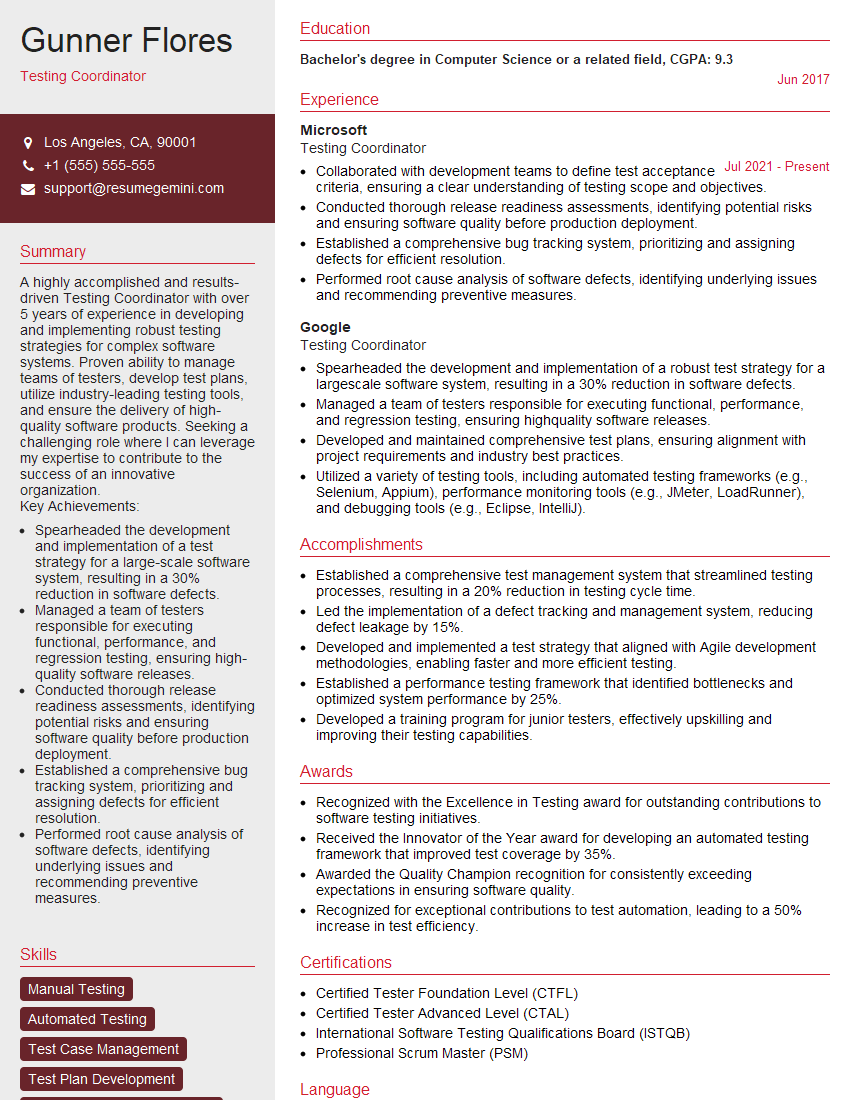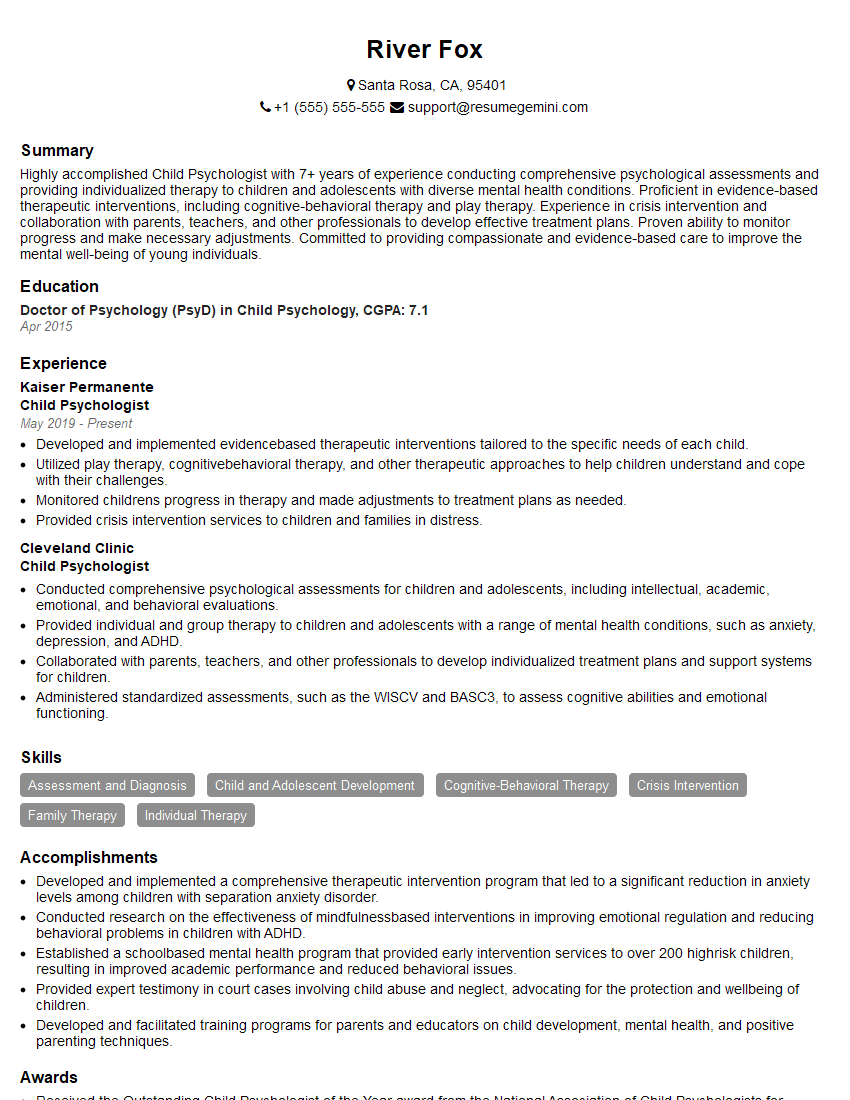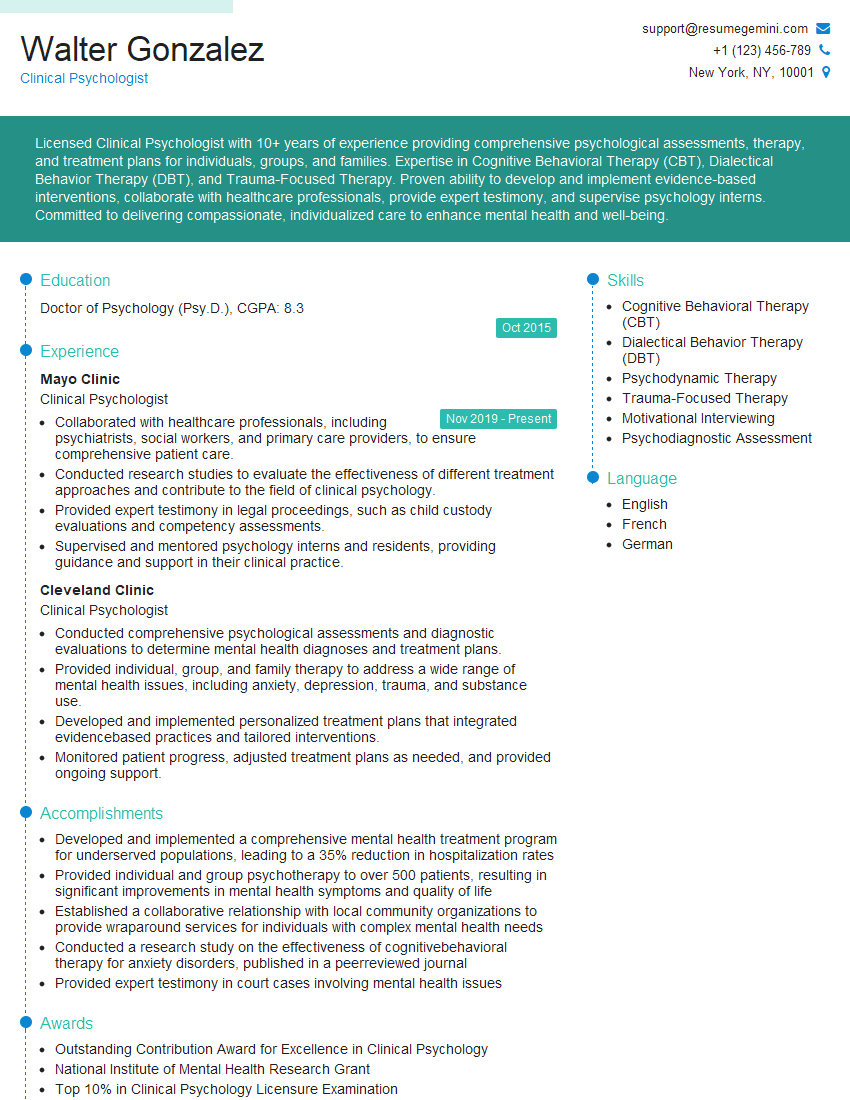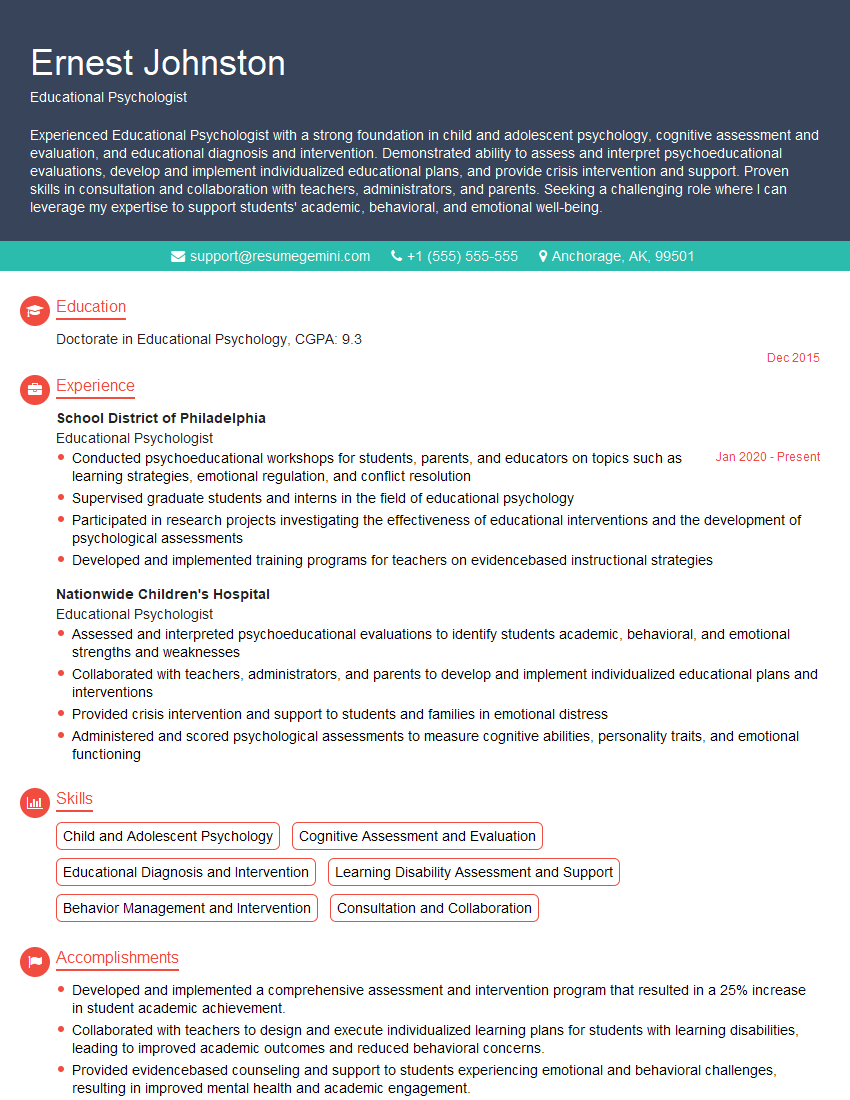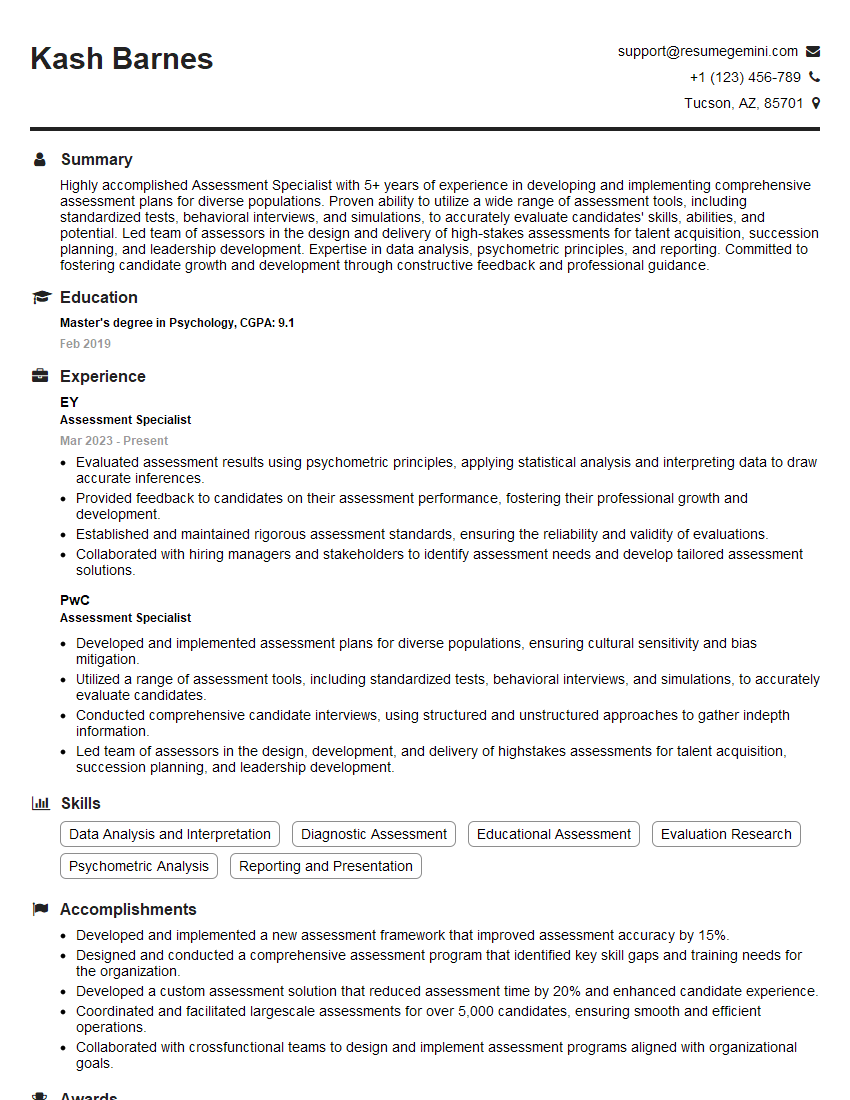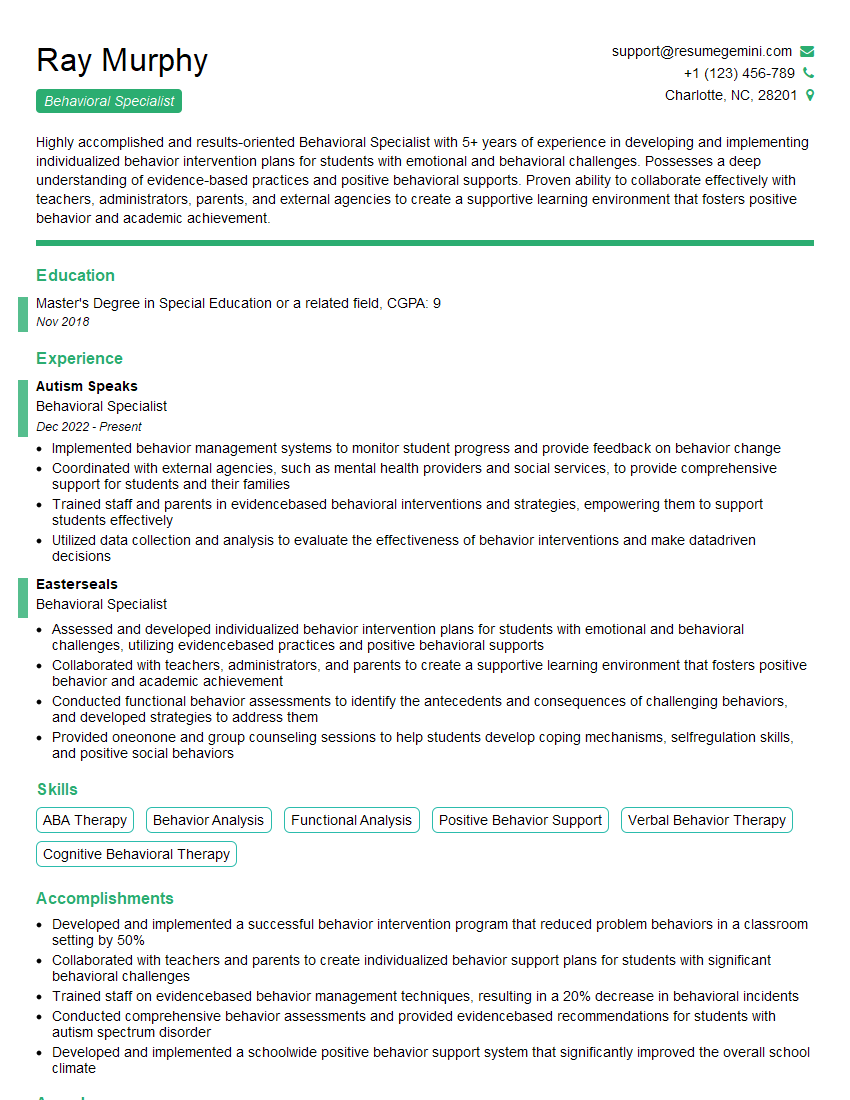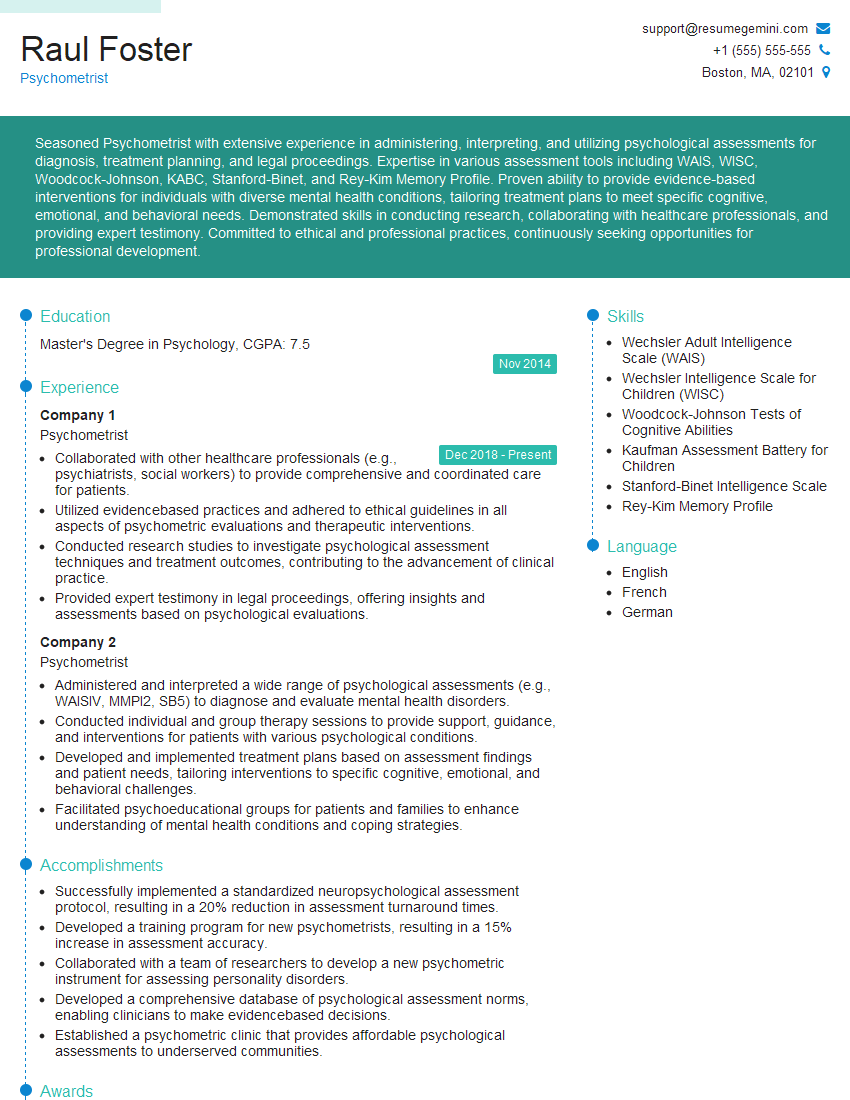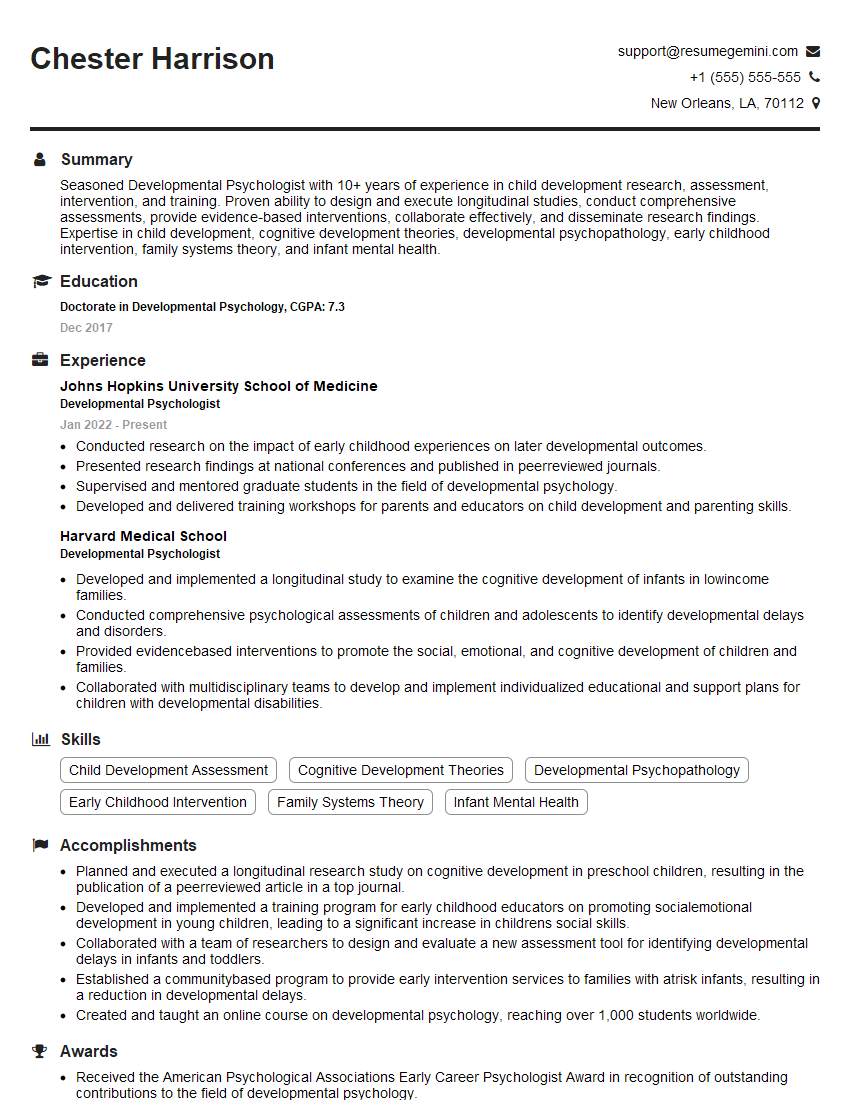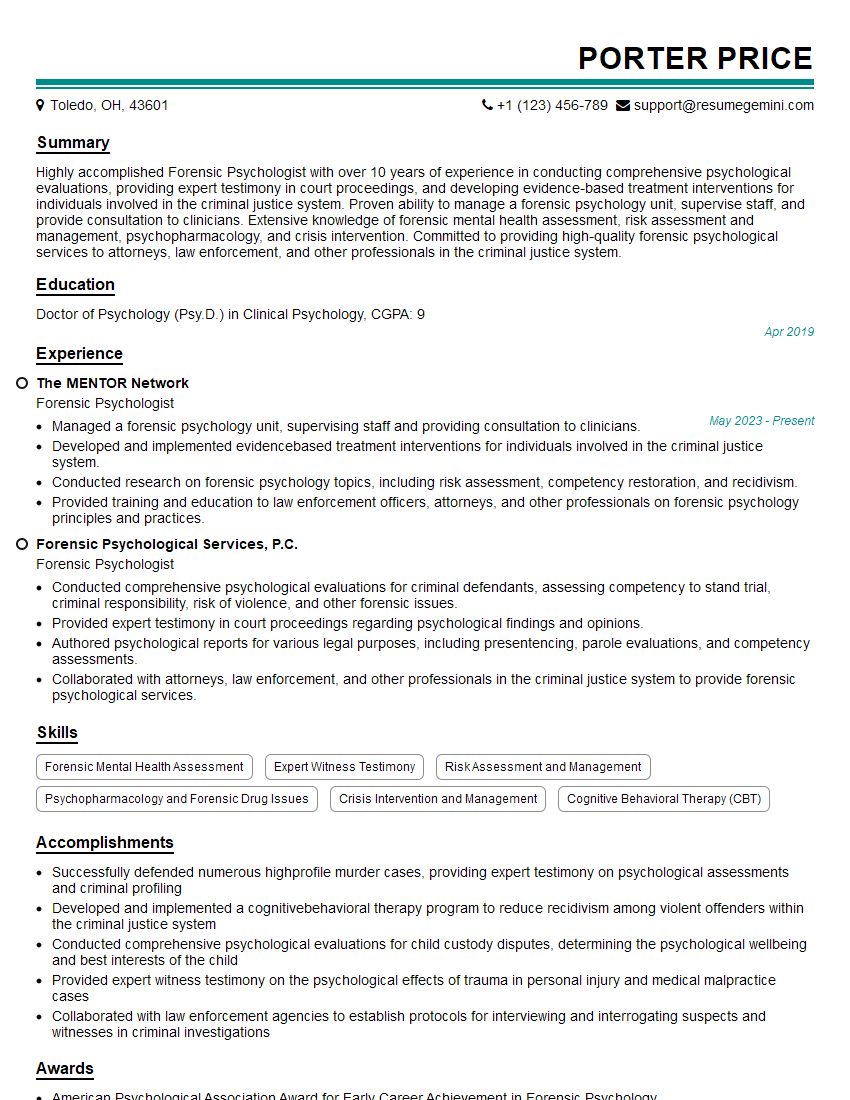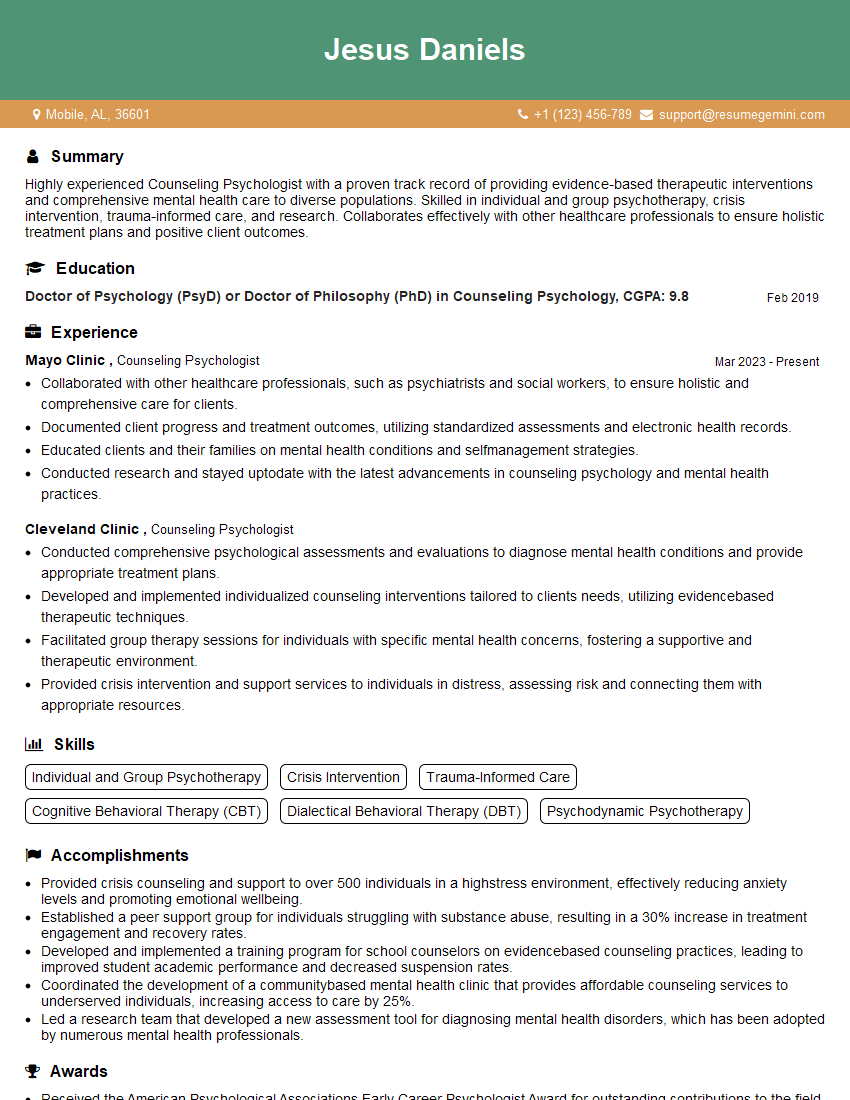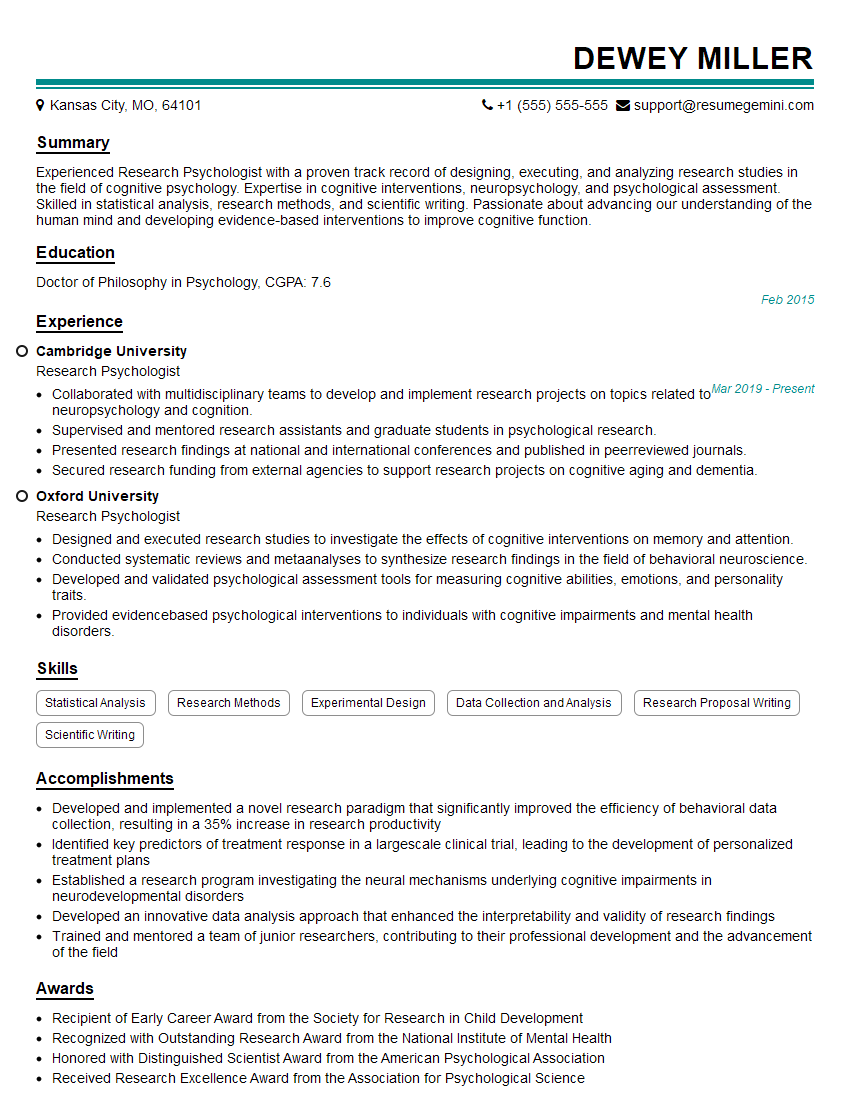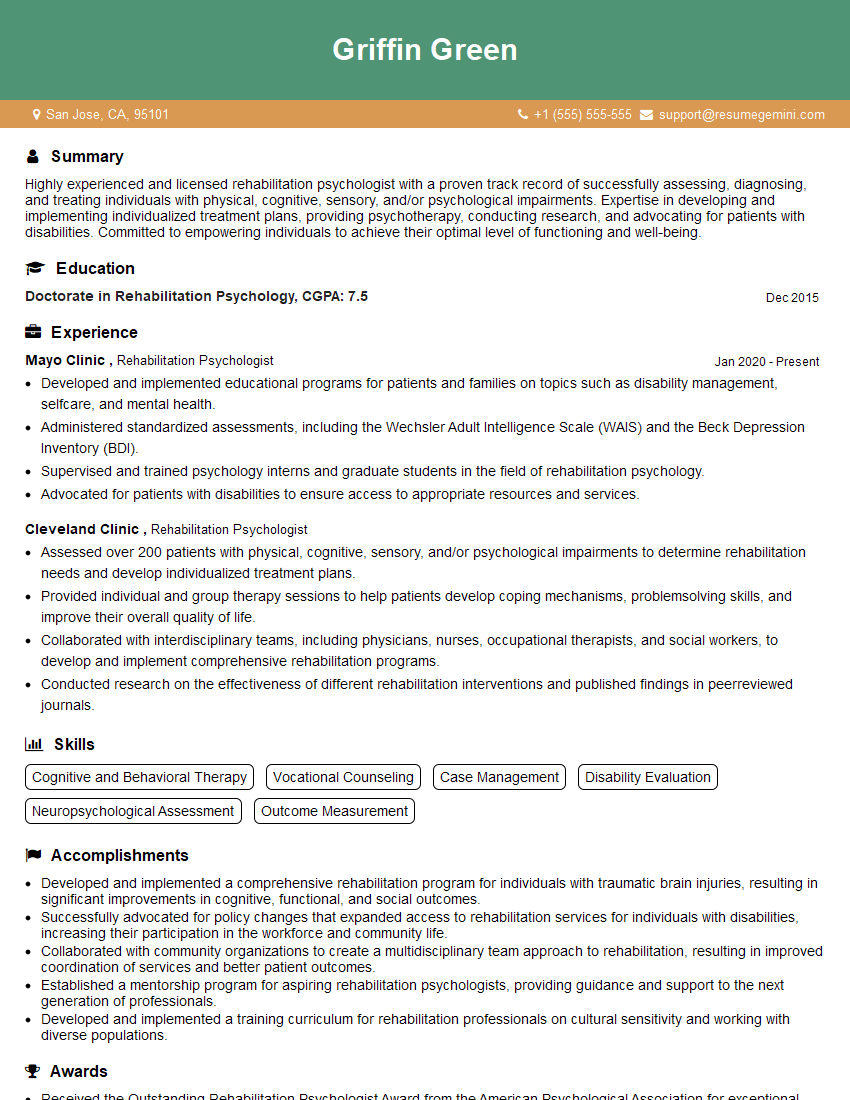Cracking a skill-specific interview, like one for Psychological Testing and Evaluation, requires understanding the nuances of the role. In this blog, we present the questions you’re most likely to encounter, along with insights into how to answer them effectively. Let’s ensure you’re ready to make a strong impression.
Questions Asked in Psychological Testing and Evaluation Interview
Q 1. Explain the difference between norm-referenced and criterion-referenced tests.
The key difference between norm-referenced and criterion-referenced tests lies in how they interpret scores. Norm-referenced tests compare an individual’s performance to the performance of a larger group, or norm group, that took the same test. Think of it like a race: you’re not judged solely on your speed, but on how your speed compares to everyone else’s. Your score is reported as a percentile rank or standard score, indicating your position relative to the norm group. Examples include the Wechsler Adult Intelligence Scale (WAIS) and the Minnesota Multiphasic Personality Inventory (MMPI).
Criterion-referenced tests, on the other hand, don’t compare you to others. Instead, they measure how well you’ve mastered specific skills or knowledge. It’s like a driving test: you’re judged on whether you meet a certain standard, not on how you compare to other drivers. Your score is reported as the percentage of items answered correctly or as a mastery level. Examples include a driver’s license exam or a chapter test in a course.
In essence: Norm-referenced tests tell you where you stand relative to others, while criterion-referenced tests tell you what you know or can do.
Q 2. Describe the process of selecting appropriate psychological tests for a specific client.
Selecting appropriate psychological tests is a crucial and multifaceted process. It starts with a thorough understanding of the client’s presenting problem and the referral question. What specific questions are we trying to answer? For example, are we assessing for cognitive impairment, personality disorders, or specific learning disabilities?
Next, we need to consider the client’s characteristics, such as age, language, culture, and cognitive abilities. A test appropriate for a highly verbal adult might be inappropriate for a young child. We need to ensure the test is valid and reliable for the specific population we are working with.
Then we review available tests that address the referral question and consider factors like test length, administration time, scoring methods, and interpretation guidelines. This may involve consulting test manuals, reviewing literature, and consulting with colleagues. The goal is to find the most efficient and effective test(s) to gather the needed information while minimizing the client’s burden.
Finally, after selecting the test, we must carefully administer and score it according to the standardized procedures. Any deviation from these procedures can compromise the test’s validity and reliability. This process is iterative and we may need to revise our approach if the initial test doesn’t provide adequate information. For example, if an initial screening tool shows a possible learning disability, further testing with specialized measures would be necessary.
Q 3. What are the ethical considerations in administering and interpreting psychological tests?
Ethical considerations are paramount in psychological testing. Confidentiality is crucial; test results must be kept secure and only shared with authorized individuals. Informed consent is essential: clients must understand the purpose of the testing, the procedures involved, the potential risks and benefits, and how the results will be used before agreeing to participate. Competence is another key element; testers must be qualified to administer, score, and interpret the chosen tests. They should be familiar with the test’s limitations and know when to refer to a colleague with specialized expertise.
Cultural sensitivity is vital. Tests must be appropriate for the client’s cultural background and avoid bias. Test fairness means ensuring that the test does not unfairly disadvantage any group of people based on race, ethnicity, gender, or other factors. Finally, responsible interpretation and feedback are critical. Test results should be communicated in a clear, understandable way, avoiding technical jargon that the client might not understand. We must focus on the client’s strengths as well as their challenges.
Ethical violations can lead to serious consequences, including malpractice lawsuits and damage to a professional’s reputation.
Q 4. How do you ensure test security and confidentiality?
Maintaining test security and confidentiality involves several strategies. Tests are often stored in locked cabinets or secure electronic databases. Access is strictly limited to authorized personnel. When administering tests, we maintain a quiet and private testing environment. After completion, test materials are properly disposed of or securely stored, according to the test publisher’s guidelines.
Confidentiality is maintained through secure record-keeping practices. We use anonymized identifiers when appropriate, and we follow the regulations of the Health Insurance Portability and Accountability Act (HIPAA), or equivalent regulations. We never discuss test results in public areas, and we ensure electronic records are password-protected and stored on secure servers.
Any breaches of confidentiality should be reported immediately to relevant authorities, and steps should be taken to mitigate the damage caused.
Q 5. Explain the concept of reliability and validity in psychological testing.
Reliability refers to the consistency of a test’s results. A reliable test will produce similar scores if administered multiple times under similar conditions. Imagine a reliable scale: it should consistently measure the same weight every time you weigh an object. In psychological testing, reliability coefficients are used to quantify this consistency. Coefficients close to 1.0 indicate high reliability. Low reliability means that the test produces inconsistent results, reducing the confidence in the scores.
Validity refers to the accuracy of a test’s results – does the test measure what it is intended to measure? A valid test accurately reflects the construct it is designed to assess. For example, an intelligence test should accurately assess intelligence, not just memory or verbal fluency. There are different types of validity, including content, criterion, and construct validity, each assessing different aspects of the test’s accuracy.
High reliability is necessary, but not sufficient, for validity. A test can be reliable (consistent) but not valid (measuring the wrong thing). However, a valid test is usually reliable.
Q 6. What are different types of reliability (e.g., test-retest, internal consistency)?
Several types of reliability assess different aspects of test consistency:
- Test-retest reliability: Measures the consistency of scores over time. The same test is administered to the same individuals on two different occasions. High correlation between the scores indicates good test-retest reliability.
- Internal consistency reliability: Measures the consistency of items within the test. This examines whether different items on the test measure the same construct. Cronbach’s alpha is a common measure used to estimate internal consistency.
- Inter-rater reliability: Measures the degree of agreement between different raters or scorers who independently score the same test. This is crucial for tests involving subjective judgment, like essay questions or behavioral observations.
- Parallel-forms reliability: This evaluates the consistency of scores obtained from two equivalent forms of the same test. It assesses the consistency of the test irrespective of specific items included.
The choice of reliability method depends on the specific test and the type of data collected.
Q 7. What are different types of validity (e.g., content, criterion, construct)?
Different types of validity provide evidence of a test’s accuracy in measuring the intended construct:
- Content validity: Refers to how well the test items represent the domain of interest. A history exam with only questions on one specific period lacks content validity. It must adequately cover the entire range of topics taught.
- Criterion validity: Examines how well the test predicts an outcome or correlates with another measure. Predictive validity refers to a test’s ability to forecast future behavior (e.g., a college entrance exam predicting college GPA). Concurrent validity refers to how well the test correlates with a current criterion (e.g., a new depression scale correlates with existing depression measures).
- Construct validity: The most complex type of validity, it assesses whether the test measures the theoretical construct it is intended to measure. This involves gathering evidence from multiple sources (convergent and discriminant validity) to support the interpretation of scores as reflecting the targeted construct (e.g., showing that a test of extraversion correlates with other measures of extraversion, but not with measures of neuroticism).
Establishing validity requires a comprehensive approach, often involving multiple methods to build a strong case for the test’s accuracy.
Q 8. How do you interpret standard scores and percentiles?
Standard scores and percentiles are crucial for interpreting psychological test results. They allow us to compare an individual’s performance to a normative sample. Standard scores, typically expressed as Z-scores, T-scores, or IQ scores, represent how far an individual’s score deviates from the mean of the normative sample in standard deviation units. A Z-score of 0 indicates the individual scored at the mean, while a Z-score of +1 indicates a score one standard deviation above the mean. Percentiles indicate the percentage of individuals in the normative sample who scored at or below a particular score. For example, a percentile rank of 75 means the individual scored higher than 75% of the normative sample.
Example: If a client achieves a T-score of 60 on an anxiety scale (where the mean is 50 and the standard deviation is 10), this indicates a score one standard deviation above the mean. If their percentile rank is 84, it means they scored higher than 84% of the individuals in the normative group for that measure of anxiety.
Q 9. Describe the process of scoring and interpreting the MMPI-2.
The Minnesota Multiphasic Personality Inventory-2 (MMPI-2) is a comprehensive personality test. Scoring involves using a computer-based system to calculate raw scores for each clinical scale (e.g., Depression, Hysteria, Psychopathy) and validity scales (e.g., Lie, Infrequency, Defensiveness). These raw scores are then converted into T-scores (mean 50, standard deviation 10). Interpretation involves considering the profile of T-scores across all scales, looking for elevations above a certain threshold (often 65 or higher), and interpreting these elevations in the context of the validity scales. Validity scales are crucial as they help assess the honesty and validity of the client’s responses. For instance, a high score on the Lie scale might suggest the client is trying to present themselves in a favorable light, impacting the interpretation of clinical scales.
Example: A client with elevated scores on the Depression and Anxiety scales, along with valid profiles on the validity scales, might suggest a diagnosis related to an anxiety or depressive disorder. However, a high score on the Infrequency scale (suggesting inconsistent or unusual responding) would require careful consideration of the test results’ reliability.
Q 10. Describe the process of scoring and interpreting the Wechsler Adult Intelligence Scale (WAIS).
The Wechsler Adult Intelligence Scale (WAIS) measures different aspects of intelligence. Scoring involves calculating raw scores for each subtest (e.g., Vocabulary, Block Design, Digit Span) which are then converted into scaled scores (mean 10, standard deviation 3). These scaled scores are summed to obtain a Full Scale IQ (FSIQ), which provides an overall measure of intelligence. The WAIS also provides separate scores for Verbal Comprehension, Perceptual Reasoning, Working Memory, and Processing Speed, offering a more comprehensive picture of cognitive abilities. Index scores are also compared to identify cognitive strengths and weaknesses. For example, a significantly lower score on Processing Speed compared to other Index scores might indicate potential processing speed deficits.
Example: A client with a FSIQ of 115 is considered above average. However, further interpretation of the index scores and subtest scores is necessary to understand their specific cognitive profile. A low score on the Digit Span subtest, for example, may reflect weaknesses in working memory.
Q 11. How do you address cultural bias in psychological testing?
Cultural bias in testing refers to the extent to which test items or procedures are unfair or inaccurate for individuals from different cultural backgrounds. Addressing this involves several strategies. First, using tests that have been normed on diverse samples representing the cultural background of the client can mitigate this issue. Second, carefully reviewing the test items to identify potentially biased content is crucial. This includes using culturally relevant stimuli and language that is accessible to all test-takers. Third, employing culturally sensitive administration and interpretation procedures are vital, considering the client’s cultural background and experiences to ensure appropriate interpretation.
Example: Using a vocabulary test with culturally specific terms would disadvantage individuals unfamiliar with those terms. Instead, using tests with universally understood vocabulary or tests with multiple subscales that compensate for culturally specific knowledge are helpful to obtain a better representation of the individual’s abilities.
Q 12. Explain the limitations of psychological testing.
Psychological testing, despite its utility, has limitations. One is that tests only measure a sample of behavior at a specific point in time and do not provide a comprehensive understanding of an individual’s personality or abilities. Test results can be influenced by factors such as the client’s motivation, anxiety, and understanding of the instructions. Also, the reliability and validity of tests vary, and the interpretation of scores requires expertise and clinical judgment, as a test score is just one piece of information. It should not be used in isolation.
Example: A client might score poorly on an intelligence test due to test anxiety, which doesn’t reflect their true cognitive abilities. Similarly, a personality test’s results may not be entirely accurate for predicting future behavior.
Q 13. How do you handle a client who is resistant to testing?
When a client is resistant to testing, it’s important to establish rapport and understand the reasons for their resistance. This might involve discussing their concerns about the testing process, explaining the purpose and benefits of the assessment, and emphasizing confidentiality. Sometimes, offering choices in the type of assessment or adjusting the testing environment can help alleviate anxiety. Forcing a client to participate is counterproductive; instead, a collaborative approach should be adopted where the client feels empowered and respected throughout the process.
Example: If a client expresses discomfort with a particular type of assessment, offering an alternative might be beneficial. Also, explaining the confidentiality of the results and how this will help in better understanding their situation can reduce their resistance.
Q 14. Describe your experience with different types of psychological tests (e.g., intelligence, personality, neuropsychological).
Throughout my career, I have extensive experience administering and interpreting various psychological tests. My experience includes comprehensive intelligence testing (WAIS, WISC), personality assessments (MMPI-2, NEO-PI-R, PAI), and neuropsychological evaluations (e.g., Halstead-Reitan Neuropsychological Battery). I am proficient in selecting appropriate tests based on the referral question and client’s needs. This includes considering factors such as age, cultural background, and presenting concerns. I am skilled in integrating test results with other clinical information to develop comprehensive evaluations and treatment recommendations.
Example: In one case, a client referred for memory difficulties underwent neuropsychological testing, revealing specific deficits in verbal memory. This was then integrated with other observations to develop a personalized treatment plan addressing those specific memory problems.
Q 15. How do you maintain objectivity when interpreting test results?
Maintaining objectivity in interpreting test results is paramount to ethical and accurate psychological assessment. It requires a conscious effort to avoid biases and rely solely on the data presented, coupled with a strong understanding of the test’s limitations. This involves several key strategies:
- Awareness of Personal Biases: Regular self-reflection on my own beliefs, values, and experiences is crucial. I actively consider how these might unconsciously influence my interpretation of test data. For example, if I have strong personal feelings about a particular issue, I might need to be particularly cautious when interpreting responses related to that issue.
- Adherence to Standardized Procedures: I meticulously follow the test’s standardized administration, scoring, and interpretation guidelines. This minimizes the introduction of subjective judgment. Deviation from these guidelines would compromise the validity and reliability of the results.
- Considering Multiple Data Points: I never rely on a single test score. Instead, I integrate the results with other assessment information, such as clinical interviews, behavioral observations, and collateral information from family or other professionals. This provides a more holistic and nuanced understanding of the individual.
- Consultation and Peer Review: In complex cases or when I am unsure, I seek consultation from experienced colleagues. This allows for a fresh perspective and helps identify any potential biases or alternative interpretations.
For instance, if a client scores high on a measure of anxiety, I wouldn’t jump to conclusions. Instead, I would explore this further in the clinical interview, looking for contextual factors that might contribute to this score. Was the client experiencing a stressful life event? Did they misunderstand any of the questions? Was there any test-taking anxiety? This multi-faceted approach prevents premature labeling and ensures a more accurate interpretation.
Career Expert Tips:
- Ace those interviews! Prepare effectively by reviewing the Top 50 Most Common Interview Questions on ResumeGemini.
- Navigate your job search with confidence! Explore a wide range of Career Tips on ResumeGemini. Learn about common challenges and recommendations to overcome them.
- Craft the perfect resume! Master the Art of Resume Writing with ResumeGemini’s guide. Showcase your unique qualifications and achievements effectively.
- Don’t miss out on holiday savings! Build your dream resume with ResumeGemini’s ATS optimized templates.
Q 16. How do you integrate test results with other assessment data (e.g., clinical interview, observations)?
Integrating test results with other assessment data is essential for a comprehensive and accurate evaluation. Test results provide quantitative data, but they don’t tell the whole story. Combining them with qualitative data from other sources paints a much richer picture of the individual.
My approach involves a collaborative and iterative process. First, I carefully review all available data – test scores, clinical interview transcripts, behavioral observations, and any relevant collateral information. Then, I look for patterns and discrepancies. Do the test results align with the client’s self-report in the interview? Are there any behavioral observations that corroborate or contradict the test findings? I carefully analyze how the different data points inform and challenge each other.
For example, a client might score high on a measure of depression, but during the interview, they may express high levels of motivation and engagement in their life. Reconciling this discrepancy requires careful consideration. Is it possible that the client is experiencing situational stress rather than clinical depression? Are there cultural factors that might influence how they express their feelings? This kind of in-depth analysis prevents misinterpretations based on isolated data points.
Finally, this integrated information guides my formulation of hypotheses about the client’s strengths and challenges and aids in developing tailored recommendations.
Q 17. Describe your experience with report writing.
Report writing is a critical skill for communicating assessment findings effectively to clients and other professionals. My reports aim for clarity, conciseness, and comprehensiveness. They adhere to professional standards and ethical guidelines, avoiding jargon whenever possible.
A typical report follows a structured format, including:
- Identifying Information: Client’s name, date of birth, referral source, etc.
- Reason for Referral: The questions the assessment aims to answer.
- Assessment Procedures: A detailed description of the tests administered.
- Results: Clear and concise presentation of test scores, avoiding unnecessary technical detail. I often use tables and graphs for better visual representation.
- Interpretation: A thoughtful integration of test results and other data, offering explanations and hypotheses. I highlight strengths and weaknesses, and contextualize the findings within the client’s life and background.
- Summary and Recommendations: A concise summary of the key findings, concluding with specific, actionable recommendations for intervention or further assessment.
I pay close attention to the audience. A report for a referring physician would differ in style and content from a report for a client. I always strive to use plain language and avoid technical terms unless necessary. For example, rather than saying “elevated levels of neuroticism,” I might say, “the client demonstrates tendencies toward worry and anxiety.”
Q 18. How do you communicate test results to clients and other professionals?
Communicating test results is as much an art as it is a science. It requires sensitivity, empathy, and clear communication skills. My approach focuses on tailoring the communication style to the audience and the context.
Communicating with Clients: I prioritize collaboration and shared understanding. I begin by explaining the purpose of the assessment and the types of tests used. I present the results in a simple, straightforward manner, avoiding technical jargon, and using visual aids where appropriate. I encourage the client to ask questions and address any concerns. I focus on empowerment, offering hope and strategies for improvement based on the results.
Communicating with Professionals: When communicating with other professionals, I utilize a more formal approach, providing a comprehensive report and outlining the rationale for my conclusions. I am prepared to discuss the findings in detail, answer any questions, and defend my interpretations. Collaboration and openness to different perspectives are key.
I always ensure that my communication respects client confidentiality and complies with ethical guidelines. A crucial element is to avoid making definitive statements and instead communicate interpretations as probabilities and hypotheses. For example, I might say, ‘The test results suggest a high likelihood of depression,’ rather than definitively stating, ‘The client has depression.’
Q 19. How do you ensure the accurate scoring and interpretation of tests?
Ensuring accurate scoring and interpretation is foundational to ethical and effective psychological testing. It involves several interconnected steps:
- Selecting Appropriate Tests: This involves careful consideration of the client’s presentation, the referral question, and the psychometric properties of available tests (reliability, validity, norms).
- Strict Adherence to Test Protocols: Thorough understanding and precise implementation of testing procedures are crucial. This includes administering the tests according to instructions, maintaining a standardized testing environment, and ensuring the client’s understanding of the tasks.
- Accurate Scoring: I use the official scoring manuals provided by the test publishers and often cross-check my scores using multiple methods where applicable. This reduces the risk of human error.
- Understanding Test Limitations: I am well-versed in the limitations of each test. I recognize that tests are just one piece of the puzzle, and I integrate findings with other data to avoid over-reliance on any single score or interpretation.
- Regular Professional Development: Ongoing education keeps me updated on best practices and ensures my knowledge remains current on test revisions and advancements.
- Using Software: I utilize specialized software to assist in scoring and data analysis, which minimizes errors and increases efficiency.
For example, if a test requires timed responses, adherence to that timing is critical. Failing to do so can significantly impact the results and invalidate the interpretations. Regular self-checking and seeking consultation reduce errors in scoring and interpretation.
Q 20. What software or tools are you familiar with for psychological testing and data analysis?
I am proficient in a range of software and tools used in psychological testing and data analysis. This includes:
- Test-specific software: Many standardized tests have their own proprietary software for scoring and report generation. I am familiar with several such programs, including those for the MMPI-2-RF, WAIS-IV, and various other personality and cognitive tests.
- Statistical software packages: I use statistical software such as SPSS and R to conduct more complex analyses of test data, including correlational analyses, factor analysis, and regression modeling. This allows me to explore relationships between different variables and identify patterns in the data.
- Electronic Health Record (EHR) systems: I am comfortable using various EHR systems to store and manage client data securely and efficiently.
The choice of software depends on the specific test and the complexity of the analysis required. My proficiency in these tools ensures accuracy and efficiency in my work.
Q 21. Describe your experience with adapting tests for individuals with disabilities.
Adapting tests for individuals with disabilities is a crucial aspect of ethical and equitable assessment. It requires careful consideration of the individual’s specific needs and the potential impact of the disability on test performance.
My approach focuses on ensuring that the assessment provides a fair and accurate measure of the individual’s abilities, not their disabilities. This may involve:
- Using alternative assessment methods: In some cases, standardized tests might not be appropriate. I might consider alternative assessment methods, such as behavioral observations, adaptive assessments, or informal measures, to gather relevant information.
- Modifying test administration: For individuals with visual impairments, I might use large print or Braille versions of tests; for individuals with hearing impairments, I might use sign language interpretation. Other modifications might include providing extra time, changing the format of questions, or using assistive technologies.
- Interpreting results cautiously: I am mindful that accommodations might influence test scores. I interpret results in light of the accommodations provided and consider the potential impact on score validity. I consult with relevant professionals to ensure appropriate interpretation.
- Selecting appropriate tests: Some tests are designed to be more accessible to individuals with disabilities. Careful test selection is important for appropriate assessment.
For example, when assessing an individual with a learning disability, I would carefully consider their specific challenges and select tests that minimize the impact of their disability on their performance. This might involve using tests that emphasize verbal reasoning rather than timed tasks, or providing additional time to complete the assessment.
Q 22. What are the key differences between projective and objective personality tests?
The core difference between projective and objective personality tests lies in their approach to assessing personality. Objective tests, like the Minnesota Multiphasic Personality Inventory (MMPI-2), utilize structured questionnaires with clear, unambiguous items and standardized scoring. They rely on the individual’s self-report to provide quantitative data. Think of it as a multiple-choice exam where the answers are pre-defined and scored objectively.
In contrast, projective tests, such as the Rorschach Inkblot Test or the Thematic Apperception Test (TAT), present ambiguous stimuli – inkblots or pictures – and ask the individual to respond freely. The responses are then interpreted by a trained clinician to uncover underlying thoughts, feelings, and motivations. It’s like providing a blank canvas and interpreting the painting created by the individual, emphasizing qualitative analysis. This approach assumes that the individual’s unique interpretation reflects their unconscious processes.
The key distinctions are summarized as follows:
- Stimuli: Objective tests use structured items; projective tests use ambiguous stimuli.
- Response format: Objective tests involve selecting pre-defined answers; projective tests involve open-ended responses.
- Scoring: Objective tests employ standardized scoring; projective tests rely on clinical judgment for interpretation.
- Focus: Objective tests measure explicit personality traits; projective tests aim to uncover implicit and unconscious aspects of personality.
Both types of tests have their strengths and weaknesses. Objective tests offer greater reliability and validity due to their structured nature, but may lack the depth to explore unconscious processes. Projective tests provide rich qualitative data but suffer from lower reliability and validity due to the subjective nature of interpretation.
Q 23. Explain the concept of standardization in psychological testing.
Standardization in psychological testing is a crucial process that ensures the test is administered and scored consistently across different settings and individuals. It aims to minimize bias and maximize the comparability of results. Think of it as creating a fair playing field for all test-takers.
Standardization involves several key aspects:
- Standardized administration: The test instructions, time limits, and procedures are consistently followed for all test-takers. This might involve specific wording, the order of presentation of questions, and the environment of testing.
- Standardized scoring: The scoring criteria are precisely defined, ensuring objectivity and consistency. This often involves numerical scoring, potentially using scoring keys or computer programs.
- Normative data: The test is administered to a large, representative sample of the population to establish norms. These norms provide a basis for comparing an individual’s score to the performance of others in the same population group, allowing for relative comparisons.
For example, if a standardized test indicates a child is performing in the 90th percentile in math, it means the child’s score is better than 90% of children in their age group. Without standardization, this comparison wouldn’t be meaningful or valid.
The goal of standardization is to improve the reliability and validity of the test. Without it, test scores would be difficult to interpret and compare, undermining the usefulness of the test.
Q 24. How do you stay current with the latest developments in psychological testing and assessment?
Staying current in the rapidly evolving field of psychological testing and assessment requires a multifaceted approach. I actively engage in several strategies to maintain my expertise:
- Professional journals and publications: I regularly read peer-reviewed journals such as the Journal of Consulting and Clinical Psychology and the Assessment journal to stay informed about new research and best practices. I also seek out relevant books and publications in the field.
- Conferences and workshops: Attendance at professional conferences like those hosted by the American Psychological Association (APA) provides opportunities to learn about the latest advancements, network with colleagues, and hear from leading experts.
- Continuing education courses: I regularly participate in continuing education courses and workshops focused on specific tests and assessment techniques. This keeps my knowledge and skills updated and ensures compliance with ethical and professional standards.
- Professional organizations: Membership in professional organizations, such as the APA’s division of assessment psychology, offers access to resources, networking opportunities, and continuing education options.
- Online resources: I utilize reputable online resources, such as databases of psychological tests and assessment-related websites from universities and professional bodies, to access information on new tests and updated information on existing tests.
This comprehensive approach guarantees I am continually developing my skills and knowledge, ensuring I provide the most up-to-date and effective psychological assessment services.
Q 25. Describe a situation where you had to explain complex test results to a client.
I once had to explain complex results from a neuropsychological battery to a client who had experienced a traumatic brain injury. The results indicated mild cognitive impairments in memory and executive functioning. The client, understandably, was anxious and overwhelmed by the technical jargon.
My approach involved:
- Using plain language: I avoided technical terms as much as possible, explaining concepts in simple, everyday language. For instance, instead of saying ‘executive dysfunction,’ I described it as challenges with planning, organizing, and problem-solving.
- Focusing on strengths and weaknesses: I highlighted both the areas of impairment and the client’s preserved cognitive strengths, providing a balanced perspective. This helped to avoid emphasizing only the negative aspects of the evaluation.
- Providing concrete examples: Instead of just stating the cognitive deficits, I gave real-life examples of how these challenges might manifest in their daily life.
- Creating a collaborative environment: I encouraged the client to ask questions and actively involved them in the discussion. This fostered trust and understanding, helping the client process the information.
- Offering realistic expectations: I provided a realistic prognosis, explaining both the potential challenges and possibilities for rehabilitation and recovery.
- Connecting with resources: I provided the client with information on relevant support services and rehabilitation programs.
This approach helped the client understand the test results without feeling overwhelmed and empowered them to take proactive steps towards their recovery.
Q 26. Describe a challenging case involving psychological testing, and how you addressed it.
A challenging case involved a young adult who presented with significant emotional distress and reported suicidal ideation. Initial self-report measures indicated high levels of anxiety and depression, but their responses seemed inconsistent and lacked internal coherence. There was a strong suspicion of response bias or malingering.
My approach involved:
- Employing multiple assessment methods: I utilized a variety of assessment tools, including both self-report measures and projective tests (like the TAT), to gather a more comprehensive picture of their psychological functioning. The projective measures allowed for a deeper exploration of their underlying emotions and motivations that weren’t easily captured through self-report.
- Careful clinical interview: I conducted a detailed clinical interview, paying close attention to inconsistencies in their responses and exploring potential reasons for any discrepancies.
- Validation of test data: I used validity scales within the self-report measures to assess the likelihood of response bias. I compared the results across different assessment methods to verify the consistency and credibility of the data.
- Collaboration with other professionals: I collaborated with the client’s therapist and psychiatrist to gather additional information and develop a comprehensive treatment plan.
Through this multifaceted approach, I was able to develop a more accurate understanding of the client’s situation and provide a tailored treatment plan addressing their needs, considering the possibility of malingering or response bias. It was a delicate balancing act between considering the client’s self-report and utilizing other methods to validate the findings.
Q 27. How would you handle a situation where you suspect test data is invalid?
Suspecting invalid test data is a serious concern that requires careful consideration and investigation. My approach follows these steps:
- Review the testing process: I would meticulously review the entire testing process, looking for any procedural errors, unusual behaviors during testing, or environmental factors that may have affected the results. Did the client understand the instructions? Were there any distractions?
- Examine validity scales: Many psychological tests include validity scales designed to detect response bias, such as malingering (faking bad) or defensiveness (faking good). I would analyze these scales carefully.
- Compare with other data: I would compare the test results with other available data, such as clinical interviews, observations, and collateral information from family members or other professionals. Do the test results align with other information collected?
- Consider alternative explanations: I would consider if there are alternative explanations for the unusual scores, such as cultural factors, language barriers, or cognitive limitations.
- If invalidity is confirmed: If the data is indeed determined to be invalid, I would not use those results in forming conclusions or recommendations. I might repeat the assessment using a different approach or test, or further investigate the reasons for the invalid data.
The ethical use of psychological assessment relies on the validity of the data. Any suspicion of invalidity necessitates a thorough investigation before proceeding with interpretation and reporting.
Q 28. What is your approach to ensuring the ethical use of psychological test data?
Ensuring the ethical use of psychological test data is paramount to my practice. My approach is guided by the principles of the APA’s ethical code and involves:
- Competence: I only administer and interpret tests for which I have adequate training and experience. This ensures that I have the necessary skills to administer tests correctly and interpret results accurately.
- Informed consent: I always obtain informed consent from clients before administering any psychological tests, ensuring they understand the purpose, procedures, and potential limitations of the assessment.
- Confidentiality: I maintain strict confidentiality regarding test results, adhering to relevant legal and ethical guidelines. Results are only shared with those who have a legitimate need to know, with client permission.
- Test security: I maintain the security and integrity of test materials, following appropriate procedures for storage, handling, and disposal to prevent unauthorized access and misuse.
- Cultural sensitivity: I am mindful of cultural factors that might influence test performance and select tests that are appropriate and valid for the client’s cultural background.
- Appropriate use of results: I use test results responsibly, avoiding over-interpretation or drawing unwarranted conclusions. I consider the results in the context of other information obtained, to reach an informed judgment.
- Feedback and explanation: I provide clients with clear and understandable feedback regarding their test results, explaining the implications of the findings in a way that is easy to understand and avoids undue distress.
Ethical considerations are integral to every step of the testing process, from selecting the appropriate instruments to reporting the results and using them to provide informed and helpful clinical guidance.
Key Topics to Learn for Psychological Testing and Evaluation Interview
- Test Selection & Administration: Understanding the principles of selecting appropriate tests based on the client’s needs and the ethical considerations involved in administering these tests. This includes knowledge of various test types and their limitations.
- Test Interpretation & Report Writing: Mastering the art of interpreting test results accurately and objectively, translating complex data into clear, concise, and actionable reports for clients or referral sources. Practice writing insightful and ethically sound reports.
- Psychometrics: A strong grasp of reliability, validity, and standardization in psychological testing. Understanding how these concepts influence the accuracy and usefulness of test results is crucial.
- Ethical and Legal Considerations: Deep familiarity with ethical guidelines, confidentiality, informed consent, and legal implications associated with psychological assessment. Prepare to discuss relevant case studies.
- Specific Test Batteries & Instruments: Demonstrate familiarity with commonly used tests relevant to the specific job description (e.g., Wechsler Scales, MMPI, projective tests). Be prepared to discuss their strengths and weaknesses.
- Diagnostic & Assessment Approaches: Understanding different assessment approaches (e.g., cognitive, behavioral, personality) and how to integrate findings from various sources to form a comprehensive evaluation.
- Case Conceptualization & Treatment Planning: Develop your ability to synthesize assessment data to formulate a clear and concise case conceptualization, leading to the development of effective treatment plans.
- Cultural Competence & Bias in Testing: Understanding the impact of cultural background and potential biases within testing instruments and interpretation, and how to mitigate these factors.
- Data Analysis & Interpretation: Demonstrate proficiency in analyzing test data, including statistical concepts relevant to interpreting scores and identifying significant trends.
- Technology & Software in Psychological Assessment: Familiarity with relevant software and technology used in psychological assessment, data management, and reporting.
Next Steps
Mastering Psychological Testing and Evaluation opens doors to diverse and rewarding career paths in various settings. A strong foundation in this area is highly valuable for career advancement and demonstrates a commitment to ethical and effective practice. To maximize your job prospects, creating an ATS-friendly resume is paramount. ResumeGemini is a trusted resource that can help you build a professional and impactful resume. We provide examples of resumes specifically tailored for professionals in Psychological Testing and Evaluation to guide you in crafting your own compelling application.
Explore more articles
Users Rating of Our Blogs
Share Your Experience
We value your feedback! Please rate our content and share your thoughts (optional).
What Readers Say About Our Blog
This was kind of a unique content I found around the specialized skills. Very helpful questions and good detailed answers.
Very Helpful blog, thank you Interviewgemini team.
